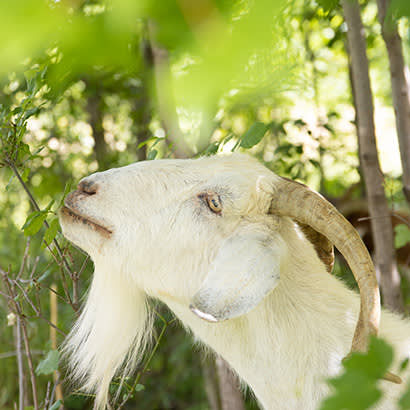
For an enhanced digital experience, read this story in the ezine.
On a sunny summer afternoon, Olmsted Parks Conservancy staff visited Summit Field in Iroquois Park to check on the goat herd they installed there as part of a land management study. As they approached the fence, they spotted a man with an easel set up among the grasses. On his canvas, the prairie landscape featured flowers, native grasses, and Savannah and Kiko goats. While the herd had a specific job to do, they offered the additional benefit of bringing people like this artist into the park and engaging them with nature.
This is just one example of how Olmsted Parks Conservancy works to elevate Louisville, Kentucky’s historic Olmsted Park System in partnership with Louisville Parks and Recreation. Louisville’s public spending is lower than that of peer cities — investment from the city averages $40 per resident, while cities of similar size put approximately $107 per resident into their parks. With money stretched thin, Louisville Parks and Recreation focuses on day-to-day needs that have an immediate effect on park usage. Emptying trash, mowing and repairs take precedence, leaving little capacity to implement plans for long-term sustainability. Olmsted Parks Conservancy’s Team for Healthy Parks (THP) fills this crucial role, managing natural areas to protect biodiversity. For example, THP removes invasive honeysuckle from woodlands, enabling the growth of young trees and spring ephemerals. The conservancy also raises private dollars to bridge the gap in funding between what the parks receive from the city budget and what they need to thrive.
Iroquois Park is one of three flagship parks anchoring the park system. In addition to Iroquois in the south, Cherokee is the flagship park in the east, and Shawnee is the flagship park in the west. Each park has unique topography, assets and challenges. While the woodlands in Iroquois are relatively healthy, with a lower invasive species threat than Cherokee Park, Iroquois Park features a 25-acre prairie that requires different management to preserve the diverse ecosystems within. A prescribed burn is often the most effective course of action for such a landscape. However, with the Louisville International Airport and UPS Worldport hub located just east of the park, very specific conditions must be met for a burn to take place. A prescribed burn was planned for spring 2023, but during the permit period spanning a week, not a single day had the right combination of moisture, wind and weather. So, what other tools can the Olmsted Parks Conservancy’s THP utilize to elevate the health of the prairie?
Research has shown good results from using grazing animals to manage invasive plants and support biodiversity in natural areas. Olmsted Parks Conservancy partnered with Kentucky State University to explore whether grazing is a viable land management option in Iroquois Park. They set up separate plots to measure the effectiveness of goat grazing against that of forestry mulcher clearing and cut-stump treatment with hand tools. Kentucky State University collected baseline data with drones and through field surveys, and then installed the goats onsite. The goat herd remained on the prairie from July to September 2023, and follow-up data has been collected. In 2024, the plot locations will be shuffled for a second round of data collection for comparison.
While the Olmsted Park Conservancy and Kentucky State University still have much to learn from the data, initial findings show that the goats are good for both the prairie and park awareness. This innovative approach to land management renewed many park users’ interest in Iroquois Park and provided learning opportunities about the diverse ecosystem within.
Jesse Hendrix-Inman is Director of Communications, Olmsted Parks Conservancy

